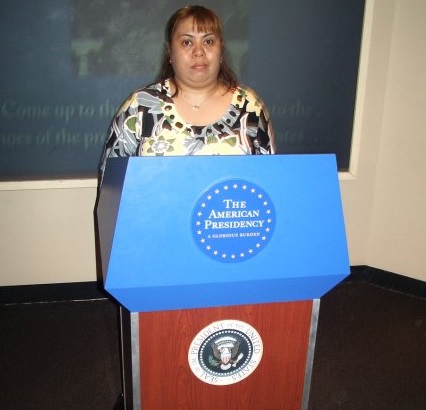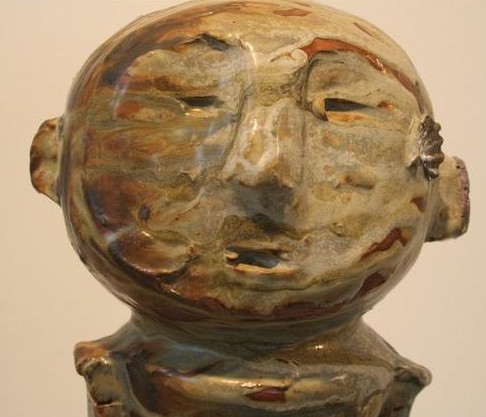Unveiling the ceramic ‘bulol’ on Independence Day
The god of harvest is getting a makeover.
Stoneware potter Hadrian Mendoza is showing 15 pieces of ceramic ‘bulol’ at the Philippine Center on Fifth Avenue from June 6 to 17 to coincide with the celebration of Independence Day on June 12. Opening night is June 8.
The traditional, wood-carved ‘bulol’ – or granary god — is an indigenous sculpture common in the northern Philippines, which is home to the world-famous Banaue Rice Terraces. The Ifugao people of Northern Luzon believed in carving their interpretation of the deity to ensure a good harvest for the season. Today, the ‘bulol’ is more of a decorative bric-a-brac found in many cosmopolitan homes.
“If you look at all the pictures of ‘bulol,’ usually in wood, as done by artisans in northern Luzon, the gesture of its face is minimal, its marks are minimal,” said Hadrian, a recipient of the Anne and Arnold Abramson award for Excellence in Ceramics courtesy of the Corcoran School of Art in Washington D.C. “From its shape, from the proportion of its head and body, you can’t seem to tell what’s going on in it in terms of emotions and feelings. Studying the faces of ‘bulol’ has given me a good feeling.”
“Two months ago, I was in a frenzy making several 30-inch tall ‘bulol’ after I was scheduled for an art exhibit in time for the Independence Day,” he said. “I worked on five pieces at a time. It felt good. It made me feel at home. I got a different world in my studio at Work House Art Centre in Lorton, Virginia. I felt as if I was not there, but in the Philippines,” he said.
Hadrian, his wife and two children left their home and studio at the foot of Mount Makiling in Laguna, southern Luzon in 2009 to return to Virginia, where he grew up. He was named artist in residence at the ceramics department of the 3-year-old Lorton Art Foundation. As soon as they arrived, he panicked that he didn’t have the right kind of clay “similar to the one I left in the Philippines.”

“I wanted the coarsest and chunkiest red clay with lots of iron. I did my research. Finally, someone introduced me to Neuman, the company that gave me the clay that I was looking for. When I got the bulk in December 2009, it looked gritty and unrefined, like the clay of that I used to work with in the Philippines,” he recalled.
After two test fires, and in order to create an organic look in his pieces, he changed the recipe of this new clay: 70 percent ball clay and kaolin, 20 percent feldspar, and 10 percent silica. The new recipe turned his glaze of oak ash (taken from the fireplace) from pale green to brownish dark brown, more orange, and dark iron red.
“I was trying to get back the comfort zone that I had in the Philippines. I was really happy that I got comfortable (with my materials) again,” he said.
Confessing how he yielded to the ‘bulol’s’ essence of quietude, Hadrian said, “I started making ‘bulol’ in its traditional form. I used a very simple technique and minimal approach in making its eyes and nose. There were very subtle changes, but nothing radical. They were very minimal. I didn’t want to disrespect it by making it too off.”
“But the feeling and emotion that you get from the minimal gestures that created the ‘bulol’ become strong. Its basic forms and basic emotions represent dull, muted, and subtle hope, but, more importantly, they are about a belief or confidence that something will come out (of nothing). It’s a strong sculpture,” he explained further.
With his deliberate choice of materials and form, his potter’s hands are decidedly reaching out to the Philippines, his roots. “Rather than guessing what to make (day after day in my studio), making ‘bulol’ has given me direction,” he said.
While in the Philippines, Hadrian became a student of Philippine master potters Jon and Tessy Pettyjohn in Calamba, Laguna. Together, they put up a pottery school in the Makati financial district. He also has his own studio in Laguna.
Hadrian Mendoza is married to Camille Dacanay. They have two daughters, Banaue, 4, and Roja, 2. They are residents of Reston, where Hadrian grew up.













Fabulous, an element of excellent job!
I read this article completely about the comparison of
hottest and earlier technologies, it’s remarkable
article.